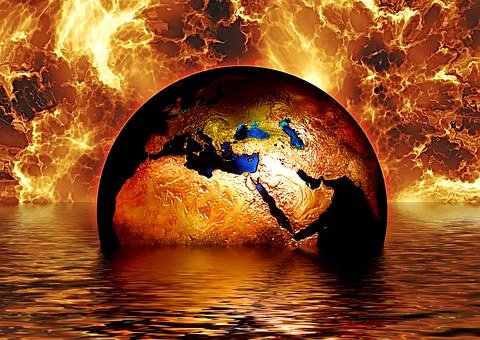Climate Change is Real – How to Stop it
How do fast-rising sea levels, intenser heat waves, hotter days, more droughts, and severe weather sound? It doesn’t sound very pleasant, but it’s pretty much inevitable if we continue to pollute and damage the Earth. With Earth Day approaching on Thursday, April 22, now is the perfect time to educate ourselves on the climate crisis that is currently occurring, and how we can combat it.
Climate change is real and the effects of it are playing out right now. Billionaire, Elon Musk, is already planning his escape to Mars, and if we continue to let things worsen, we might have to join him on his flight (projected to cost $500,000 per person).
Although we tend to think we aren’t seeing the impacts of climate change, they are right in front of us. My first realization was when I took a trip to San Francisco in November of seventh grade, a few days after the 2018 California Wildfires (an effect of climate change). Like every tourist, I went to see the sights. I remember riding an elevator to the top of a large tower that overlooked San Francisco. People say the view is spectacular, and I’ll have to take their word for it because there was so much smoke in the air that I wasn’t able to see anything. Climate change ruined the whole point of my trip, not to mention the air pollution and the worry I had about my lungs.
The Cause of Climate Change
The main cause of climate change is the increasing buildup of greenhouse gasses (carbon dioxide, methane, nitrous oxide, fluorinated gasses) in the atmosphere released by fossil fuels, such as coal and gas. These greenhouse gasses, particularly carbon dioxide, cause global warming by trapping heat in the atmosphere, as well as a variety of other consequences.
Only 100 fossil fuel companies are to blame for 71% of greenhouse gas emissions and are the main contributors to climate change and global warming. They spend billions of dollars to hide the truth about the damage fossil fuels have on the environment.
Instead of using fossil fuels and polluting the air, consumers could switch to using renewable energy, such as wind, solar, and hydropower energy. These energy sources produce no greenhouse gasses (the main cause of climate change) and reduce certain types of air pollution.
Even though renewable energy sources are better for the environment, most people continue to use fossil fuels because fossil fuel companies spend heaps of money on subsidies that make fossil fuels cheaper, making it harder for renewable energy sources to compete.
What to Expect in the Future
Since 1901, the Earth’s average temperature has been increasing by about 0.15 degrees Fahrenheit per decade and the Intergovernmental Panel on Climate Change (IPCC) believes that over the next century the temperature will rise 2.5 to 10 degrees Fahrenheit.
Other changes we can expect besides hotter days are more heatwaves and droughts (instead of one every 20 years, it will happen every two to three years), a continued increase in precipitation, and frequent hurricanes that will be stronger and more powerful.
We can also expect a continued rise in the average sea level, which has risen by 8 inches since 1880 and will rise another 1 to 8 feet by 2100. This rise is due to the warmer temperatures melting ice.
An increase in flooding is also expected due to the combination of the sea level rise and increase in precipitation. The rising sea level will also destroy the habitats of many animals, causing a major disturbance in our wildlife.
How to Stop Climate Change
Because of the amount of damage that has already been done to our atmosphere, these changes to our environment will continue through the foreseeable future. But, the severity of the consequences depends on the destruction we continue to allow.
Since the main cause of the climate crisis is the usage of fossil fuels, the solution with the greatest impact would be to switch to using clean energy. As individuals, we can minimize the damage we cause to the environment and do our part to help protect Earth. Below are 7 easy things you can do to make an impact.
- Reduce, Reuse, Recycle! Practice the three Rs. Cut back on what you throw away and try using reusable products (containers, water bottles, utensils). By doing this, you are lowering the amount you waste and are conserving landfill space.
- Conserve water! The water you use will end up in the ocean, along with any chemicals that may have been added. Remember to turn off that sink when you are not actively using it!
- Reduce your plastic waste! Only 9% of the plastic we use ends up recycled and 8 million tons end up in the ocean. Instead of using plastic, try using reusable items. Stop buying plastic water bottles and plastic shopping bags, and start using reusable ones.
- Use other forms of transportation! Reduce the amount of gas you release into the atmosphere. Try walking, biking, carpooling, and using public transit when you are able to.
- Plant a tree! A young tree can absorb 13 pounds of CO2 a year, and a tree of 10 years can absorb 48 pounds each year.
- Reduce energy use! Remember to turn off appliances when you are not using them and switch to LEDs, which last longer and are very energy-efficient. And, if possible, switch your energy source to renewables.
- Compost! Try giving composting a try! Composting will reduce the amount of waste you add to the landfill, and if you have a home garden, compost makes a great fertilizer to grow your plants in.
It’s extremely important that we find a way to efficiently cut back on our carbon footprints and switch to environmentally friendly energy sources because if we don’t, we are going to be taking that trip to Mars with Elon Musk real soon.


